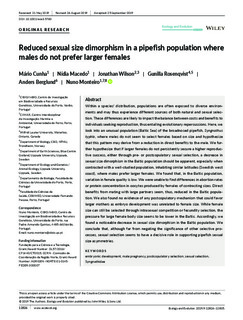| dc.description.abstract | Within a species' distribution, populations are often exposed to diverse environ‐ments and may thus experience different sources of both natural and sexual selec‐tion. These differences are likely to impact the balance between costs and benefits to individuals seeking reproduction, thus entailing evolutionary repercussions. Here, we look into an unusual population (Baltic Sea) of the broadnosed pipefish, Syngnathus typhle, where males do not seem to select females based on size and hypothesize that this pattern may derive from a reduction in direct benefits to the male. We fur‐ther hypothesize that if larger females do not persistently secure a higher reproduc‐tive success, either through pre‐ or postcopulatory sexual selection, a decrease in sexual size dimorphism in the Baltic population should be apparent, especially when contrasted with a well‐studied population, inhabiting similar latitudes (Swedish west coast), where males prefer larger females. We found that, in the Baltic population, variation in female quality is low. We were unable to find differences in abortion rates or protein concentration in oocytes produced by females of contrasting sizes. Direct benefits from mating with large partners seem, thus, reduced in the Baltic popula‐tion. We also found no evidence of any postcopulatory mechanism that could favor larger mothers as embryo development was unrelated to female size. While female size can still be selected through intrasexual competition or fecundity selection, the pressure for large female body size seems to be lower in the Baltic. Accordingly, we found a noticeable decrease in sexual size dimorphism in the Baltic population. We conclude that, although far from negating the significance of other selective pro‐cesses, sexual selection seems to have a decisive role in supporting pipefish sexual size asymmetries. | nb_NO |

